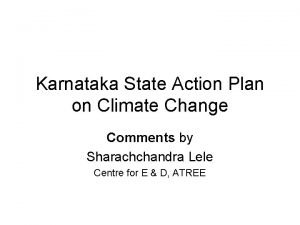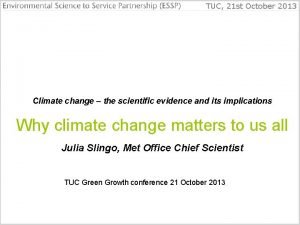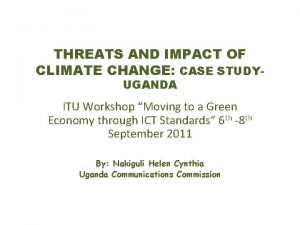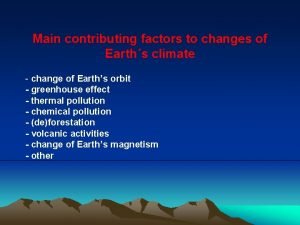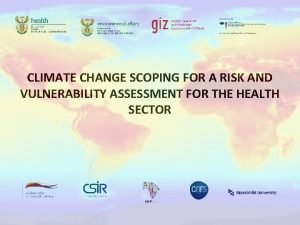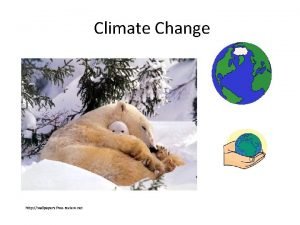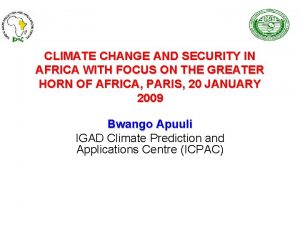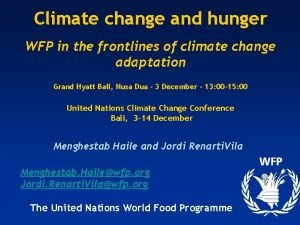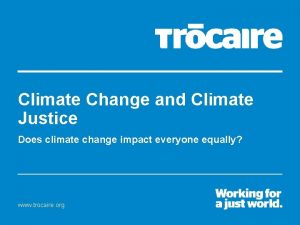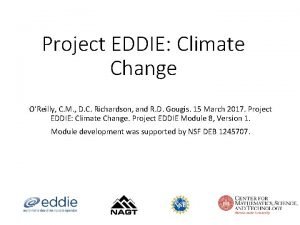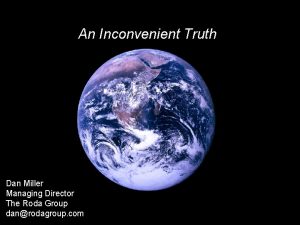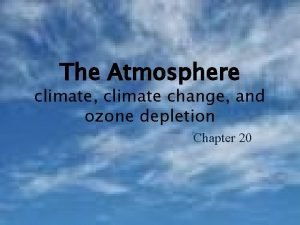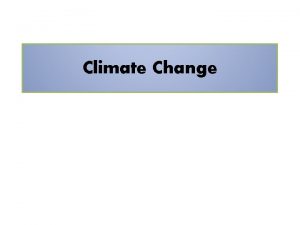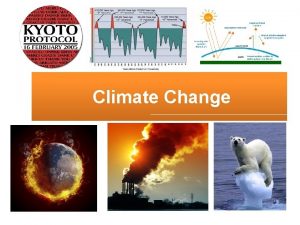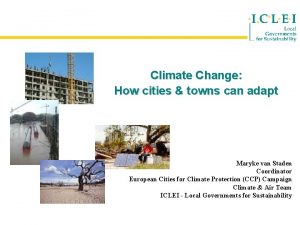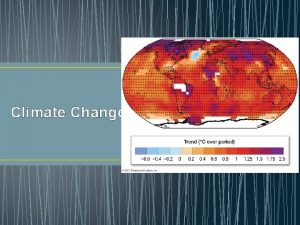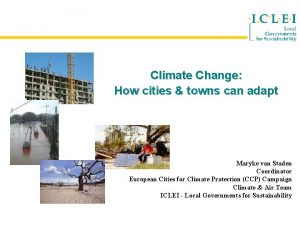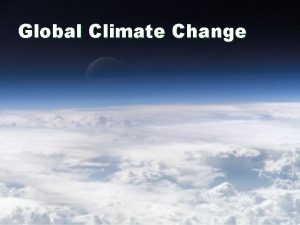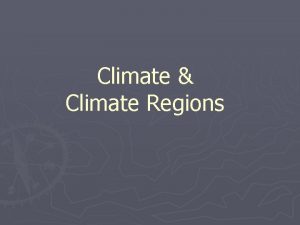Issues surrounding NH highlatitude climate change Alex Hall

































- Slides: 33

Issues surrounding NH highlatitude climate change Alex Hall UCLA Department of Atmospheric and Oceanic Sciences

surface albedo feedback has been thought for quite some time to be a possible contributor to high-latitude climate sensitivity… --Budyko (1969), Sellers (1969) --Manabe and Stouffer (1980) --Robock (1983) --Ingram et al. (1989) --Meehl and Washington (1990) --Bitz and Holland (2003)

classical climate sensitivity framework climate sensitivity parameter change in net incoming shortwave with SAT change in outgoing longwave with SAT

Climate sensitivity parameter Change in net incoming shortwave with SAT surface albedo feedback to d. Q/d. Ts. Change in outgoing longwave with SAT change in solar radiation with surface albedo change in surface albedo with SAT

Simulated reduction in reflected solar radiation at the top of the atmosphere due to CO 2 doubling (Hall, 2004)

Geographical and seasonal distribution of the quasiequilibrium SAT response to CO 2 -doubling.

Geographical and seasonal distribution of the SAT sensitivity when surface albedo feedback is suppressed.

Latitude-height cross-section of warming due to CO 2 doubling when surface albedo feedback is present.

Latitude-height cross-section of warming due to CO 2 doubling when surface albedo feedback is absent.

Climate sensitivity parameter Change in net incoming shortwave with SAT Surface albedo feedback to d. Q/d. Ts. Change in outgoing longwave with SAT change in solar radiation with surface albedo change in surface albedo with SAT

Could clouds neutralize ice albedo feedback? To address this question, we examine the controls on planetary albedo in the recent climate record.

What is the surface contribution to planetary albedo variations? (Qu and Hall, 2005) standard deviation of seasonal-mean planetary albedo (%) in the ISCCP D 2 data set broken down by season

We assess the controls on planetary albedo variability by examining the ISCCP D 2 data set (1983 -2000). For both clear and all-sky cases, the ISCCP data set (D 2) contains (1) surface radiation fluxes (2) TOA radiation fluxes These were generated based on observations at 3 different channels (visible, near IR, and IR) and a radiative transfer model. Rossow and Gardner (1993 a and b) J Clim. Rossow and Schiffer (1999) BAMS.

Planetary albedo variability can be divided into contributions from four components: (1) SURFACE: the portion unambiguously related in linear fashion to surface albedo variability (2) CLOUD: The portion unambiguously related in linear fashion to cloud cover and optical depth variability (3) RESIDUAL: The portion that cannot be linearly related to either surface or cloud variability (4) COVARIANCE: The portion linearly related to surface and cloud variability but not unambiguously attributable to either. (1) (2) (3) (4) SURFACE CLOUD RESIDUAL COVARIANCE

We defined six regions, guided by known differences in the behavior of surface albedo variability: (a) northern hemisphere snow-covered lands (b) northern hemisphere sea ice zone (c) southern hemisphere sea ice zone (d) snow-free lands (e) ice-free ocean (f) Antarctica (g) We averaged the contributions of the four components over each region for each season and normalized by the total planetary albedo variability. Note that the definition of the regions varies seasonally. SURFACE CLOUD RESIDUAL COVARIANCE

contributions from the four components normalized by total planetary albedo variability in ISCCP SURFACE CLOUD RESIDUAL COVARIANCE

The magnitude of the covariance term is generally small, indicating that interannual variability in surface albedo and cloud are largely uncorrelated. However, on land in the SH sea ice zone, it is not negligible, suggesting surface-cloud interaction. SURFACE CLOUD RESIDUAL COVARIANCE

The magnitude of the residual term is larger than the covariance term but is also generally small, except over Antarctica and the sea ice zones during winter. This may be due to nonlinear dependence of planetary albedo on surface albedo and cloud SURFACE CLOUD RESIDUAL COVARIANCE

The cloud contribution to planetary albedo variability in ISCCP dominates the snowfree lands and the icefree oceans SURFACE CLOUD RESIDUAL COVARIANCE

The surface contribution to planetary albedo variability in ISCCP is significant everywhere except for the ice-free oceans. It is dominant in the SH sea ice zone year around, and in the other cryosphere regions for most of the year. SURFACE CLOUD RESIDUAL COVARIANCE

The surface contribution to planetary albedo variability in ISCCP is significant everywhere except for the ice-free oceans. It is dominant in the SH sea ice zone year around, and in the other cryosphere regions for most of the year. SURFACE CLOUD RESIDUAL COVARIANCE

The surface contribution to planetary albedo variability in ISCCP is significant everywhere except for the ice-free oceans. It is dominant in the SH sea ice zone year around, and in the other cryosphere regions for most of the year. SURFACE CLOUD RESIDUAL COVARIANCE

The surface contribution to planetary albedo variability in ISCCP is significant everywhere except for the ice-free oceans. It is dominant in the SH sea ice zone year around, and in the other cryosphere regions for most of the year. SURFACE CLOUD RESIDUAL COVARIANCE

The surface contribution to planetary albedo variability in ISCCP is significant everywhere except for the ice-free oceans. It is dominant in the SH sea ice zone year around, and in the other cryosphere regions for most of the year. SURFACE CLOUD RESIDUAL COVARIANCE

Comparison to a climate model To allow for as direct a comparison with the ISCCP data as possible, we used a simulated time series with approximately the same mix of internal variability and externally-forced climate change: a recent CCSM 3 scenario run (T 85) data taken from the same time period as ISCCP (1983 -2000).

Controls on planetary albedo variability in CCSM 3 SURFACE CLOUD RESIDUAL COVARIANCE

CCSM 3 ISCCP A side-by-side comparison of CCSM 3 and ISCCP reveals much more contribution from the surface in ISCCP to interannual planetary albedo variability in all regions except for ice-free oceans. SURFACE CLOUD RESIDUAL COVARIANCE

ISCCP DJF MAM JJA SON CCSM 3 DJF MAM JJA SON The surface contribution is larger in both sea ice and snow zones of the NH. The difference is particularly striking over the NH snow-covered lands, with planetary albedo variability in CCSM 3 being overwhelmingly determined by cloud rather than surface variations.

Why is the contribution of the surface so much smaller in CCSM 3? --Is it that clouds are more variable, increasing the relative contribution of clouds? --Or is it that the CCSM 3 atmosphere is more opaque to solar radiation, attenuating the effect of surface albedo anomalies? --Or is surface albedo itself less variable in CCSM 3?

ISCCP Clear-sky surface albedo standard deviation (%) in ISCCP and CCSM 3, broken down by season. ISCCP has consistently more surface albedo variability. CCSM 3

ISCCP Clear-sky surface albedo standard deviation (%) in ISCCP and CCSM 3, broken down by season. The larger surface albedo variability in ISCCP is particularly apparent in the interior of the northern hemisphere snowpack. (e. g. DJF) CCSM 3

ISCCP Clear-sky surface albedo standard deviation (%) in ISCCP and CCSM 3, broken down by season. A similar pattern is seen in NH spring. CCSM 3

a couple of conclusions The surface contribution to planetary albedo variability in ISCCP is significant everywhere except for the ice-free oceans. If surface albedo were to vary in cryosphere regions in the future, the planet’s shortwave radiation absorption would be significantly affected. CCSM 3 has substantially less surface albedo variability than ISCCP, particularly in the interior of ice and snow packs, resulting in a much smaller simulated contribution of the surface to planetary albedo variability. This may lead to ways to improve the model’s surface albedo parameterization.
 Climate change 2014 mitigation of climate change
Climate change 2014 mitigation of climate change Social issues in information technology
Social issues in information technology What ethical issues surrounding executive compensation
What ethical issues surrounding executive compensation Persuasive essay about global warming
Persuasive essay about global warming Karnataka state action plan on climate change
Karnataka state action plan on climate change What causes wind to blow brainpop
What causes wind to blow brainpop Climate change meaning
Climate change meaning Atmosphere
Atmosphere Unit 9 climate change
Unit 9 climate change Conclusion of climate change
Conclusion of climate change Youreuropemap.com
Youreuropemap.com Conclusion of climate change
Conclusion of climate change Mathematics of climate change
Mathematics of climate change Climate change definition ap world history
Climate change definition ap world history Climate change mitigation
Climate change mitigation 414 climate change
414 climate change Conclusion of climate change
Conclusion of climate change Factors of climate change
Factors of climate change Conclusion of climate change
Conclusion of climate change Conceptual framework maker
Conceptual framework maker Uk climate change
Uk climate change Climate change interview
Climate change interview Factors affecting global warming
Factors affecting global warming Conclusion of climate change
Conclusion of climate change Conclusion of climate change
Conclusion of climate change Climate change causing droughts
Climate change causing droughts Chapter 13 atmosphere and climate change
Chapter 13 atmosphere and climate change Climate change hypothesis
Climate change hypothesis How global warming works
How global warming works Financing education in a climate of change
Financing education in a climate of change Climate change pathos
Climate change pathos Dan miller climate change
Dan miller climate change Un climate change
Un climate change What is arhetorical question
What is arhetorical question




